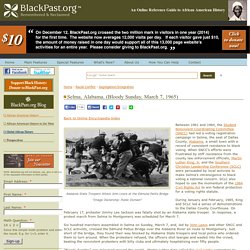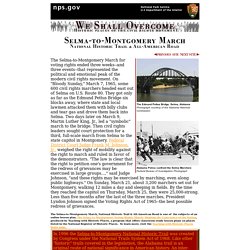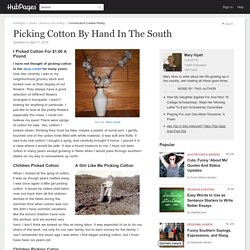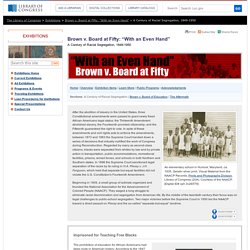

Remembering the Rosewood Massacre. Remains of Sarah Carrier's house in Rosewood, Florida, claimed to have been taken January 4, 1923 but probably taken in the days following One of the reasons that knowing history, especially a history that was covered up and buried, is important, is that it helps explain the present day.

Ten Things You Should Know About Selma Before You See the Film. In this 50th anniversary year of the Selma-to-Montgomery March and the Voting Rights Act it helped inspire, national media will focus on the iconic images of “Bloody Sunday,” the words of Dr.

Martin Luther King Jr., the interracial marchers, and President Lyndon Johnson signing the Voting Rights Act. This version of history, emphasizing a top-down narrative and isolated events, reinforces the master narrative which civil rights activists describe as, “Rosa sat down, Martin stood up, and the white folks came South to save the day.” But there is a “people’s history” of Selma that we all can learn from—one that is needed especially now. The exclusion of Blacks and other people of color from voting is still a live issue. Women in the Civil War — History.com Articles, Video, Pictures and Facts. My TV provider is not listed.

Why not? We are currently working on adding more TV providers. Please check back frequently to see if your TV provider has been added. Why do I need to log in to watch some video content? Viewers who verify their subscription to a TV provider get access to a deeper catalog of video content, including more full episodes. Gullah Words. Return to top Return to opening page.

Gullah Culture - Elementary. South. Bloody Sunday, Selma, Alabama, (March 7, 1965) Alabama State Troopers Attack John Lewis at the Edmund Pettis Bridge "Image Ownership: Public Domain" Between 1961 and 1964, the Student Nonviolent Coordinating Committee (SNCC) had led a voting registration campaign in Selma, the seat of Dallas County, Alabama, a small town with a record of consistent resistance to black voting.

When SNCC’s efforts were frustrated by stiff resistance from the county law enforcement officials, Martin Luther King, Jr. and the Southern Christian Leadership Conference (SCLC) were persuaded by local activists to make Selma’s intransigence to black voting a national concern. SCLC also hoped to use the momentum of the 1964 Civil Rights Act to win federal protection for a voting rights statute.
Selma-to-Montgomery March. The Selma-to-Montgomery March for voting rights ended three weeks--and three events--that represented the political and emotional peak of the modern civil rights movement.

On "Bloody Sunday," March 7, 1965, some 600 civil rights marchers headed east out of Selma on U.S. Route 80. They got only as far as the Edmund Pettus Bridge six blocks away, where state and local lawmen attacked them with billy clubs and tear gas and drove them back into Selma. Two days later on March 9, Martin Luther King, Jr., led a "symbolic" march to the bridge. Then civil rights leaders sought court protection for a third, full-scale march from Selma to the state capitol in Montgomery. Culture & Change: Black History in America. S Resources for Black History.
AwesomeStories is a one stop shop of primary source materials.

It is a gathering place of sources located at national archives, libraries, universities, museums, historical societies and government-created websites. The site includes documents, videos, audio clips and narrations. Topics range from the Women's Movement to Emperor Penguins to Abraham Lincoln to the Easter Story (through medieval/renaissance art) and much more. Picking Cotton By Hand In The South. Working In The Cotton Fields When we got to the field to work, each person was given a big sack to hold the cotton as it was picked.

These were just big sacks with a strap that went over the shoulder. That left both hands free to pick. The KKK and racial problems. The Ku Klux Klan was basically based in the south of America. Here they targeted those set free after the American Civil War - the African Americans. The KKK had never considered the former slaves as being free and terrorised Africa American families based in the South.
America experienced great economic prosperity during the 1920's but not much of it filtered to the South. Racism mixed with anger at their economic plight formed a potent cocktail. A Century of Racial Segregation 1849–1950 - Brown v. Board at Fifty: "With an Even Hand" An elementary school in Hurlock, Maryland, ca. 1935.

Gelatin silver print. Visual Material from the NAACP Records, Prints and Photographs Division, Library of Congress (20A). Slavery in America. The History of Slavery in America. The U.S. Gulag: Incarceration and the 'immorality' of private prisons. Convict workers at Mississippi's Parchman prison in 1911.

(Photo by the New York Times via Wikipedia.) JACKSON, Miss. -- Mariachi guitarist Johnny Mora's bout with drugs was years in his past, but the legacy of jail time it led to is as much a companion as his guitar when he travels to perform in clubs and restaurants around Mississippi. "I was afflicted, and by the grace of God I am here today," Mora said at the recent "Crimmigration: The Tragic Consequences of U.S. Drug Policies on Families and Youth" conference in Jackson sponsored by the Mississippi Immigrants Rights Alliance and Southern Christian Leadership Conference.
THE BLACK VERNACULAR. The Institute for Southern Studies - A Voice for a Better South. Black Civil Rights In America. Picking Cotton By Hand In The South. Geechee and Gullah Culture. 101 Interesting Facts about the Civil War. The Civil War was the bloodiest war ever fought on American soil. During an average day during the war, approximately 600 people were killed. By the end of the war, over 618,000 people had died. Sharecropping and tenant farming. Sharecropping was common throughout the South well into the twentieth century, and required the work of entire families. In this famous photograph, a six year-old girl picks cotton in Oklahoma.
Project Team Beta. The Institute for Southern Studies. Civil War Soldiers Database - American Civil War Service Records. Agriculture in North Carolina during the Great Depression. Originally published as "Difficult Days on Tar Heel Farms" by RoAnn Bishop Reprinted with permission from the Tar Heel Junior Historian. Fall 2010.Tar Heel Junior Historian Association, NC Museum of History “Well somebody told us Wall Street fell But we were so poor that we couldn’t tell.
African American Odyssey: The Civil Rights Era (Part 2) North Carolina, USA Locations for Sunrise Sunset Calendar.